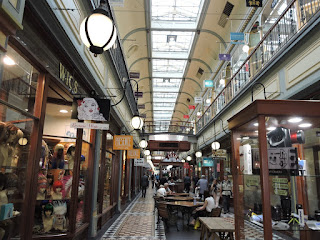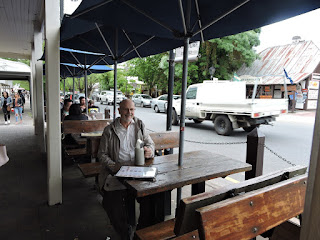(Magyar változat a végén)
We arrived in Adelaide on Wednesday morning, 25 Oct. We had pre-booked accommodation for 5 nights in the caravan park nearest to the city. It was easy to find thanks to our GPS navigation system.
 |
| Street-art in the pedestrian mall |
 |
| The old post office |
 |
| St. Peters Cathedral |
 |
| One of the arcades in the centre |
Most of the old public buildings - parliament, railway station, convention centre, war memorial, art gallery - are along the North Terrace, which is now a big mess due to the tram extension project. The classic building of the railway station is now used as a casino, while the trains are running below ground.
 |
| Ayers House - the family dining room |
 |
| Ayers House |
 |
| Botanic Gardens - Bicentennial Conservatory, the largest single-span glass house in Australia |
 |
| The cactus garden |
 |
| The Amazon waterlily |
 |
| Glenelg, Centenary Memorial |
One day we visited some of the beaches beside the town. Glenelg is the most well-known and busiest with direct tram services from the city. Wide sandy beach, parking and walkways lined by the typical Norfolk pines, big hotels and residences. This is where the pioneer settlers landed in 1836. The memorial commemorating the 100th anniversary of the foundation of the province of South Australia stands behind the long jetty.
 |
| Brighton beach |
A bit further South, Brighton beach was quieter and more to our liking.
 |
| Port Adelaide |
 |
| Hahndorf main street |
 |
| Hahndorf - the sign is inviting but the shop is closed... |
The last morning, Sunday 29. Oct, we spent in the Art Gallery and enjoyed it very much. The building itself is very impressive, and the collections - European, Australian and Aboriginal - are enjoyable.
 |
| Art Gallery |
 |
| Aboriginal collection in the Art Gallery |
The weather was fairly variable during our stay, one day 18 degrees, the next 32 and windy, then again 19 only. We can't complain though, it was quite good for sight seeing.
Monday morning we continued our journey Southbound.
----------------------
Szerdán (okt. 25) délelőtt érkeztünk Adelaide-be. Már előre lefoglaltuk a helyet 5 éjszakára a városközponthoz legközelebbi kempingben. Ilyenkor jól jön a GPS, könnyen odataláltunk.
 |
| A Szabadkőművesek központja (Masonic Hall) a lezárt North Terrace-on |
 |
| A városháza |
Délután körülsétáltunk a belvárosban, a gyalogos főutcában. Itt is jártunk már a gyerekekkel 1996-ban, de azóta elég sokat változott a város. Tipikus nagyváros, kb. 1 millió lakos, a központban vannak magas épületek, széles bulvárok, tipikus 19. szd-i homokkő középületek, nagy forgalom, gyalogosok, autók. A város többi része lapos, sűrűn fásított széles utcákkal, kertes családi házakkal.
 |
| Egy régi édességbolt kirakata |
 |
| Adelaide Oval (krikett-pálya) |
 |
| Ayers House - dísz-ebédlő |
 |
| Trópusi őserdő a botanikus kertben |
 |
| Pálmház és kaktusz-kert |
 |
| Museum of Economic Botany |
 |
| Így készül a profi cocktail |
 |
| Glenelg |
Kicsit délebbre Brighton beach csendesebb, de ugyanolyan szép.
 |
| Brighton beach |
 |
| Hahndorf főutcája |
 |
| Hahndorf - itt söröztem 21 éve, ma már csak a korsót foghatom |
Utolsó nap (okt. 29), a művészeti galériát jártuk végig. Maga az épület is impresszív, van Európai, Ausztrál és Aboriginal gyűjtemény.
 |
| A galéria egyik pavilonja |
 |
| Aboriginal művek |
Hétfőn tovább indultunk dél felé.
No comments:
Post a Comment